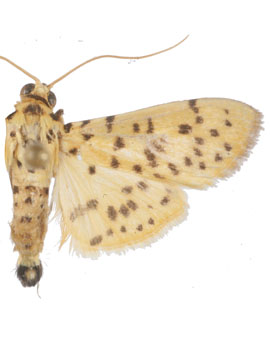Conogethes punctiferalis Guenée, [1854]; PED 15

-
Taxonomy
The holotype of Astura punctiferalis Guenée, 1854: 320 is from India. Comb. rev. to Conogethes (Shaffer et al., 1996).
Syn. Deiopeia detracta Walker, 1859a: 186, originally described in the Arctidae and transfered to the Pyraustinae [Dichocrocis]. Syn. n. (Shaffer et al., 1996). TL Singapore. The type is in the U.M. Oxford.
Syn. Astura guttatalis Walker, [1866] 1865:1381. TL Ceram Syn. n. (Shaffer et al., 1996).
??Syn. Botys nicippealis Walker, 1859e: 999; TL Ceram. Syn. n. (Shaffer et al., 1996). This is probably incorrect. That type looks nothing like the holotype of C. punctiferalis.
Nec syn. Astura semifascialis Walker [1866] 1865: 1381. TL Australia (Moreton Bay). This was considered a black suffused variety of C. punctiferalis (Guenée, 1854) by Guenée (var A). TL Khasis, or var nigralis Warren 1896: 168. TL Khasis (type in the NHM). Shaffer et al. (1996) consider C. semifascialis as a good sp. in its own right with C. nigralis and C. jubata (Lucas, 1900: 152). TL Australia, Brisbane) as junior subjective syns. -
Description
Wing length: 12mm. This common moth with intensely yellow wings and small black spots is the most densely spotted Conogethes sp. and is distinctive. The spotting is usually very discrete but in some specimens the spots are enlarged or partly joined as lines and although the FW and HW are a similar and also bright yellow they may be a paler yellow in some specimens. A specimen seen from Danum Valley has pale HWs but the spots are edged by darker orange. The FW of the same specimen has a very large pale blotch on each FW. There is usually evidence of this pale patch. Note the spots join to form a diagonal line near the HW anal angle. The thorax and abdomen are also bright yellow with black spots. The abdominal tip of the males is black scaled.
-
Distribution & Habitat
Pakistan, Sri Lanka, India (Maharashtra, Karnataka, Central, Assam, Sikkim, Meghalaya), Bhutan, Nepal, Burma (Ava), W. Malaysia, Singapore, Sabah, Brunei, Indonesia [East Indies], Batchian, Mysol, Seram, Ava), Philippines, China (N), Taiwan, Korea, Japan, New Guinea, Australia (Q, NSW). Lowland, mainly in cultivated areas, also in disturbed forest. Absent from primary forest in Sabah..
-
Life History & Pest Status
'The yellow peach moth' is a serious multivoltine, polyphagous pest of a very wide range of cultivated plants, from an unusually wide range of families. The eggs are glued to the surface and the newly hatched larvae bore into the fruit or sometimes a shoot. It has five larval instars but deveopment time depends on the foodplant. Food plants include; turmeric Curcuma longa, ginger Zingiber officinale (Zingiberaceae), rambutan Nephelium lappaceum, lychee Litchi chinensis (Sapindaceae), sapodilla Manilkara zapota (Sapotaceae), mulberry Morus nigra (Moraceae), pawpaw [papaya] Asimina triloba, custard apple Annona reticulata (Annonacea), Livingstonia Palm Livistonia humilis, coconut Cocos nucifera (Arecaceae), sunflowers Helianthus annuus (Asteraceae), durian Durio zibethinus (Bombacaceae), castor oil plant Ricinus communis (Euphorbiaceae), billy goat plum Planchonia careya (Lecythidaceae), sorghum Sorghum bicolor, maize Zea mais (Poaceae), macadamia Nuts Macadamia integrifolia (Proteaceae), peach Prunus persica (Rosaceae), various Citrus e.g. lemon, orange, (Rutaceae), eggplant Solanum melongena (Solanaceae), flame tree Brachychiton acerifolium (Sterculiaceae), cardamom Elettaria cardamomum (Zingiberaceae), cotton Gossypium hirsutum, cocoa, Theobroma cacao (Malvaceae), mango Manganifera indica (Anacardiaceae), pomegranate Punica granatum (Lythraceae) and pea Pisum sativum (Fabaceae).
Several workers have identified the pheromones involved in mating (Kimura & Honda, 1999) and males of this sp. were found to communicate with females by emitting loud ultrasound (103 dB peak equivalent sound pressure level at 1 cm; dominant frequency 82 kHz) before attempting copulation (Nakano et al. 2012). -
Similar spp.
C. punctiferalis group spp.
C. nicippealis -
Unrelated Look-alikes
No content available.
-
References
Guenée, A. (1854) Deltoïdes et pyralites. In Boisduval, J.A. & Guenée, A., Hist. nat. des Insectes (Spec. gén. Lépid.) Vol. 8, 448pp. + 10 pls., Librarie Encyclopédique de Roret: Paris.
Nakano, R., Takanashi, T., Ihara, F., Mishiro, K., Toyama, M., Ishikawa, Y (2012) Ultrasonic courtship song of the yellow peach moth, Conogethes punctiferalis (Lepidoptera: Crambidae). Appl. Entomol. Zool., 47: 87-93.
Kimura, T, & Honda, H. (1999) Identification and possible functions of the hairpencil scent of the yellow peach moth, Conogethes punctiferalis (Guenée) (Lepidoptera: Pyralidae). Appl. Entomol. Zool., 34: 147-153.
Walker, F. (1859a) Catalogue of the heterocerous Lepidoptera collected at Singapore by Mr. A.R. Wallace with descriptions of new species. J. Proc. Linn. Soc. 3: 183-198.
Walker, F. ([1866 Jan 13] 1865) List Spec Lepid. Ins. Coll. B. M., Cat. Lepid. Heterocera. 34, (Suppl. 4): 1121-1533.
Walker, F. (1859e) Pyralides, In; List Spec. Lepid. Ins. Coll. B. M., Cat. Lepid. Heterocera. Ser. 4, 19: 799-1036. -
Genitalia
No content available.
-
DNA Barcode
No content available.
-
3D Imaging
No content available.
-
Spare
No content available.
KEY TO TABS
(1) Taxonomy, (2) Description, (3) Distribution & Habitat, (4) Life History & Pest Status, (5) Similar spp., (6) Unrelated Look-alikes, (7) References, (8) Genitalia, (9) DNA Barcode, (10) 3D Imaging, (11) Spare

